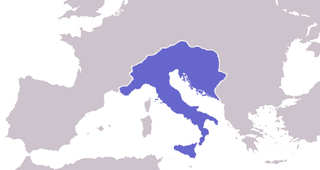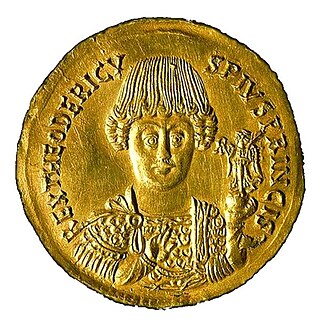Related Research Articles
The 470s decade ran from January 1, 470, to December 31, 479.
The 530s decade ran from January 1, 530, to December 31, 539.
The 500s decade ran from January 1, 500, to December 31, 509.
The 510s decade ran from January 1, 510, to December 31, 519.
The 520s decade ran from January 1, 520, to December 31, 529.
The 540s decade ran from January 1, 540, to December 31, 549.
The 480s decade ran from January 1, 480, to December 31, 489.
The 450s decade ran from January 1, 450, to December 31, 459.
The 460s decade ran from January 1, 460, to December 31, 469.
Year 489 (CDLXXXIX) was a common year starting on Sunday of the Julian calendar. At the time, it was known as the Year of the Consulship of Probinus and Eusebius. The denomination 489 for this year has been used since the early medieval period, when the Anno Domini calendar era became the prevalent method in Europe for naming years.
Year 490 (CDXC) was a common year starting on Monday of the Julian calendar. At the time, it was known as the Year of the Consulship of Faustus and Longinus. The denomination 490 for this year has been used since the early medieval period, when the Anno Domini calendar era became the prevalent method in Europe for naming years.

Year 493 (CDXCIII) was a common year starting on Friday of the Julian calendar. At the time, it was known as the Year of the Consulship of Albinus and Eusebius. The denomination 493 for this year has been used since the early medieval period, when the Anno Domini calendar era became the prevalent method in Europe for naming years.

Year 496 (CDXCVI) was a leap year starting on Monday of the Julian calendar. In the Roman Empire, it was known as the Year of the Consulship of Paulus without colleague. The denomination 496 for this year has been used since the early medieval period, when the Anno Domini calendar era became the prevalent method in Europe for naming years.
Year 488 (CDLXXXVIII) was a leap year starting on Friday of the Julian calendar. At the time, it was known as the Year of the Consulship of Ecclesius and Sividius. The denomination 488 for this year has been used since the early medieval period, when the Anno Domini calendar era became the prevalent method in Europe for naming years.
Year 492 (CDXCII) was a leap year starting on Wednesday of the Julian calendar. At the time, it was known as the Year of the Consulship of Anastasius and Rufus. The denomination 492 for this year has been used since the early medieval period, when the Anno Domini calendar era became the prevalent method in Europe for naming years.

Year 495 (CDXCV) was a common year starting on Sunday of the Julian calendar. At the time, it was known as the Year of the Consulship of Viator without colleague. The denomination 495 for this year has been used since the early medieval period, when the Anno Domini calendar era became the prevalent method in Europe for naming years.

Year 497 (CDXCVII) was a common year starting on Wednesday of the Julian calendar. At the time, it was known as the Year of the Consulship of Anastasius without colleague. The denomination 497 for this year has been used since the early medieval period, when the Anno Domini calendar era became the prevalent method in Europe for naming years.

Year 515 (DXV) was a common year starting on Thursday of the Julian calendar. At the time, it was known as the Year of the Consulship of Florentius and Anthemius. The denomination 515 for this year has been used since the early medieval period, when the Anno Domini calendar era became the prevalent method in Europe for naming years.
Euphemius of Constantinople was Ecumenical Patriarch of Constantinople (490–496). Theophanes calls him Euthymius. Prior to his appointment, Euphemius was a presbyter of Constantinople, administrator of a hospital for the poor at Neapolis, unsuspected of any Eutychian leanings, and is described as learned and very virtuous.

The Ostrogothic Kingdom, officially the Kingdom of Italy, existed under the control of the Germanic Ostrogoths in Italy and neighbouring areas from 493 to 553.
References
- ↑ Wolfram, History of the Goths, p. 281
- ↑ "List of Rulers of Korea". www.metmuseum.org. Retrieved 19 April 2019.
- ↑ The End of Empire (p. 275). Christopher Kelly, 2009. ISBN 978-0-393-33849-2
- ↑ Robertson, A. H. F.; Parlak, Osman; Ünlügenç, Ulvi Can (2013). Geological Development of Anatolia and the Easternmost Mediterranean Region. Geological Society of London. p. 461. ISBN 9781862393530.
- ↑ Leemans, Johan; Matz, Brian J.; Verstraeten, Johan (2011). Reading Patristic Texts on Social Ethics: Issues and Challenges for the Twenty-First Century. Washington, DC: The Catholic University of America Press. p. 56. ISBN 9780813218595.
- ↑ Magill, Frank Northen; Aves, Alison; Moose, Christina J.; Rehn, Mark (1998). Dictionary of World Biography: The Middle Ages. Vol. II. London and New York: Routledge. p. 559. ISBN 9781579580414.
- ↑ Martin, Peter (1997). The Chrysanthemum Throne: A History of the Emperors of Japan. Honolulu, HI: University of Hawaii Press. p. 33. ISBN 9780824820299.
- 1 2 Loomis, Louise Ropes (2006) [1916]. The Book of the Popes (Liber Pontificalis). Merchantville, NJ: Arx Publishing, LLC. pp. 114–115. ISBN 9781889758862.
- ↑ Penn, Imma (2007). Dogma Evolution & Papal Fallacies. Bloomington, IN: AuthorHouse. p. 223. ISBN 9781452059945.
- ↑ Nicholson, Oliver (2018). The Oxford Dictionary of Late Antiquity. Vol. 1. Oxford: Oxford University Press. pp. 1631–1632. ISBN 9780192562463.
- ↑ Guidoboni, Traina, 1995
- ↑ "John Malalas | Byzantine chronicler". Encyclopedia Britannica. Retrieved 4 April 2019.
- ↑ Ashkenazi, Gary (31 October 2013). "Byzantine Gold Coin Found in Tomb of Emperor Jiemin of Northern Wei". Primal Trek. Retrieved 2019-02-03.
- ↑ McNally, Frank (31 May 2018). "The Birdman of Glendalough – An Irishman's Diary about St Kevin". The Irish Times . Retrieved 4 February 2019.
- ↑ Doe, Paula; Dee, Paula; Ōtomo, Yakamochi (1982). A Warbler's Song in the Dusk: The Life and Work of Ōtomo Yakamochi (718-785) . Berkeley, Los Angeles, London: University of California Press. pp. 6. ISBN 9780520043466.
Emperor Ninken 498.
- ↑ Knechtges, David R.; Taiping, Chang (2014). Ancient and Early Medieval Chinese Literature (vol. 2): A Reference Guide, Part Two. Vol. II. Leiden, Boston: BRILL. p. 1282. ISBN 9789004201644.